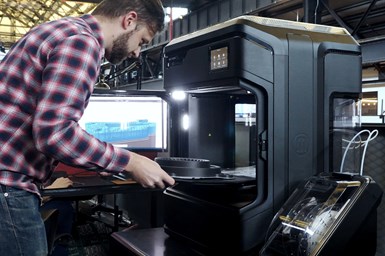UltiMaker’s Method XL 3D Printer for Engineering Applications
The printer features a temperature-controlled heated build chamber and heated build plate, enabling users to print large production parts with manufacturing-grade ABS.
UltiMaker’s Method XL was developed as a 3D printing solution for engineering applications, offering precision printing with industrial-grade materials without compromising on part size. The 3D printer is designed to deliver the accuracy and performance of industrial production alongside the flexibility and affordability of a desktop 3D printer.
The printer bridges the gap between desktop and industrial 3D printers by delivering a fusion of accessibility and performance. With a spacious 305 × 305 × 320-mm build volume and a dimensional accuracy of ± 0.2 mm, it enables customers to tackle ambitious projects — from functional prototyping to end-use parts.
Method XL is engineered to create large, complex parts that are durable using industrial-grade materials such as ABS-R and ABS carbon fiber. The heated chamber, which can reach up to 100°C, is designed to enable optimal results when printing with ABS, one of the most popular and challenging materials to successfully print on a desktop 3D printer due to its tendency to warp and deform.
The Method XL’s heated build plate is an added feature to the company’s Method printer series, offering customers an extra layer of security to avoid warping and layer adhesion issues. Both the heated build plate and the temperature-controlled heated build chamber combine to create a stable environment for printing accurate and strong parts of any size.
“UltiMaker’s mission is to grow the adoption of 3D printing in manufacturing. We saw that there was a lack of production-level industrial capabilities in more accessible and easy-to-use 3D printers,” says Nadav Goshen, UltiMaker CEO. “With Method XL, we believe we are bringing customers the best 3D printing solution in the market for engineering applications. Method XL is the only 3D printer in its price class with a heated chamber and heated build plate to print large and accurate parts with injection molding plastics like ABS. With the ability to print larger parts, customers can achieve greater output and efficiency, making Method XL an excellent choice for those looking to take their 3D printing to the next level.”
With its expansive build volume, high dimensional accuracy, heated build chamber and heated build plate, Method XL can print production plastics at a fraction of the cost of industrial machines and with the ease of desktop 3D printers. Combined with RapidRinse — a fast-dissolving, water-soluble support material — Method XL makes printing with ABS an even simpler and smoother process. RapidRinse enables one of the fastest support removals for complex FDM parts, resulting in a more refined surface finish, the company says. For a seamless CAD file-to-printed-part workflow, Method XL syncs directly with CloudPrint software, enabling customers to easily upload, monitor and track their print jobs from their web browser.
Method XL expands the arena of possibilities, offering compatibility with a wide range of industrial-grade materials through its open materials platform and the LABS Experimental Extruder. Materials currently available through the LABS program include Jabil SEBS, a soft material with flexible, rubber-like properties; Polymaker PolyMax PC, a polycarbonate material that combines strength, toughness and heat resistance; and LEHVOSS PAHT 9891, a carbon fiber-reinforced nylon able to withstand high temperatures.
Method XL also offers an external moisture-controlled material case, ensuring peak performance from professional-grade materials. The printer comes equipped with a HEPA filter and an activated carbon filter for safer 3D printing indoors.
- Read about Ultimaker’s Metal Expansion Kit for 3D Printing, which was developed to remove existing process bottlenecks and limitations in printing metal parts, and is compatible with the Ultimaker S5 Platform.
- Learn about the Ultimaker merger with MakerBot. By combining teams and leveraging additional funding, the merged company aims to accelerate the development of advanced solutions to provide customers with a broad portfolio of hardware and software solutions to serve a wide spectrum of customers and applications.
- Check out this article about Ultimaker 5.0 Cura open source, slicing software that enables finer, faster prints. The software’s enhanced slicing engine is said to enable thinner walls and finer details in additive manufacturing.
Related Content
Multimaterial 3D Printing Enables Solid State Batteries
By combining different 3D printing processes and materials in a single layer, Sakuu’s Kavian platform can produce batteries for electric vehicles and other applications with twice the energy density and greater safety than traditional lithium-ion solutions.
Read MoreDMG MORI: Build Plate “Pucks” Cut Postprocessing Time by 80%
For spinal implants and other small 3D printed parts made through laser powder bed fusion, separate clampable units resting within the build plate provide for easy transfer to a CNC lathe.
Read More3D Printing with Plastic Pellets – What You Need to Know
A few 3D printers today are capable of working directly with resin pellets for feedstock. That brings extreme flexibility in material options, but also requires greater knowledge of how to best process any given resin. Here’s how FGF machine maker JuggerBot 3D addresses both the printing technology and the process know-how.
Read MoreCasting With Complexity: How Casting Plus 3D Printing Combine the Strengths of Both
Aristo Cast is advancing a mode of part production in which casting makes the part, but 3D printing enables the geometry.
Read MoreRead Next
Hybrid Additive Manufacturing Machine Tools Continue to Make Gains (Includes Video)
The hybrid machine tool is an idea that continues to advance. Two important developments of recent years expand the possibilities for this platform.
Read More4 Ways the Education and Training Challenge Is Different for Additive Manufacturing
The advance of additive manufacturing means we need more professionals educated in AM technology.
Read More3D Printing Brings Sustainability, Accessibility to Glass Manufacturing
Australian startup Maple Glass Printing has developed a process for extruding glass into artwork, lab implements and architectural elements. Along the way, the company has also found more efficient ways of recycling this material.
Read More













.png;maxWidth=300;quality=90)










